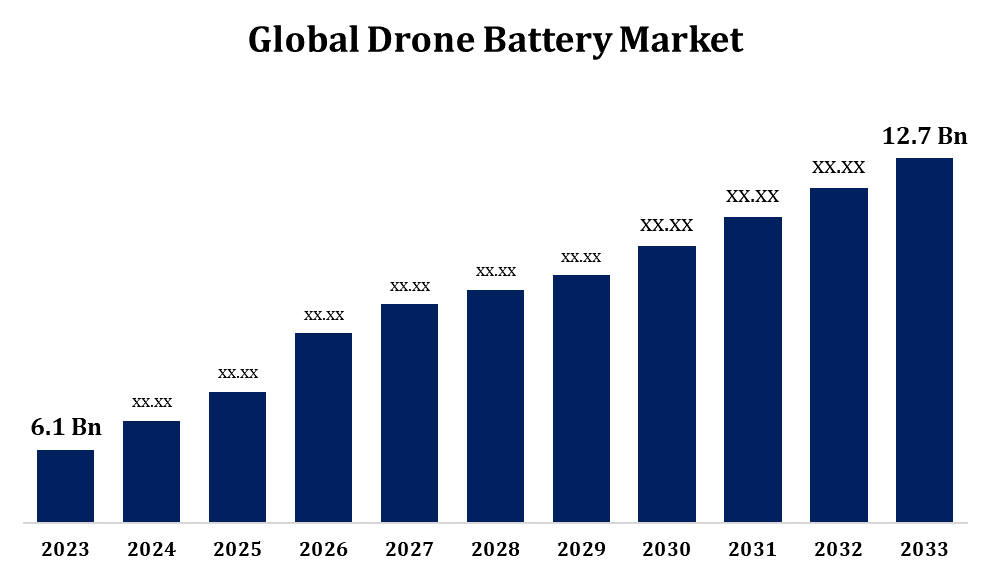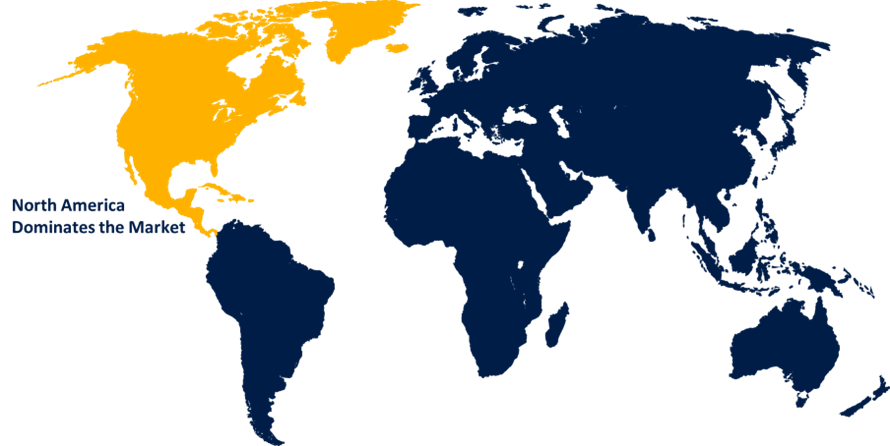Global Drone Battery Market Size To Worth USD 12.7 Billion By 2033 | CAGR of 7.61%
Category: Aerospace & DefenseGlobal Drone Battery Market Size To Worth USD 12.7 Billion By 2033
According to a research report published by Spherical Insights & Consulting, the Global Drone Battery Market Size to Grow from USD 6.1 Billion in 2023 to USD 12.7 Billion by 2033, at a Compound Annual Growth Rate (CAGR) of 7.61% during the forecast period.

Get more details on this report -
Browse key industry insights spread across 212 pages with 110 Market data tables and figures & charts from the report on the "Global Drone Battery Market Size, Share, and COVID-19 Impact Analysis, by Technology (Lithium-based, Nickel-based, Fuel Cell), by Component (Cell, BMS, Enclosure, Connector), by Drone Type (Fixed-wing, Fixed-wing VTOL, Rotary-wing), and By Region (North America, Europe, Asia-Pacific, Latin America, Middle East, and Africa), Analysis and Forecast 2023 - 2033." Get Detailed Report Description Here:https://www.sphericalinsights.com/reports/drone-battery-market
The drone battery market is growing rapidly, fueled by rising demand for drones across sectors like defense, agriculture, logistics, and aerial photography. Advances in lithium-ion and lithium-polymer battery technology are enhancing flight time, efficiency, and safety. With the expansion of both commercial and recreational drone applications, manufacturers are prioritizing high-capacity, lightweight, and fast-charging battery solutions. The industry is also seeing progress in solid-state and hydrogen fuel cell batteries for extended endurance. However, challenges such as limited energy density, battery longevity, and environmental disposal concerns persist. Leading companies like DJI, Panasonic, and LG Chem, along with innovative startups, are driving efficiency improvements. North America and Asia-Pacific lead the market, supported by growing investments in drone technology and battery advancements.
Drone Battery Market Value Chain Analysis
The drone battery market value chain encompasses several key stages, from raw material acquisition to end-user deployment. It starts with sourcing essential materials like lithium, cobalt, and nickel for battery production. Battery cell manufacturers then develop lithium-ion or lithium-polymer cells, which are integrated into battery packs by assemblers. These packs undergo rigorous testing and quality checks before being distributed to drone manufacturers. Distributors and retailers play a vital role in ensuring accessibility for commercial, industrial, and consumer drone users. Sustainability is increasingly emphasized, with companies focusing on battery recycling and eco-friendly disposal solutions. Advancements in battery technology, including solid-state innovations, are reshaping the value chain by improving energy efficiency, longevity, and overall performance, driving further market evolution.
Drone Battery Market Opportunity Analysis
The drone battery market offers significant growth opportunities, driven by the expanding use of drones in defense, agriculture, logistics, and commercial sectors. The need for longer flight durations and enhanced energy efficiency is spurring innovation in high-capacity, fast-charging, and lightweight battery solutions. Developments in solid-state and hydrogen fuel cell batteries present promising advancements in endurance and safety. The rising deployment of drone swarms and autonomous UAVs in military and industrial applications further boosts battery demand. Additionally, regulatory support for drone technology and the growth of drone delivery services are unlocking new market prospects. Emerging regions in Asia-Pacific and Latin America hold untapped potential, while sustainable battery recycling solutions create opportunities for eco-conscious enterprises. Increased R&D investments in energy-dense and cost-effective batteries will be crucial for future market expansion.
The drone battery market is experiencing rapid growth, driven by increasing demand across various industries, including defense, agriculture, logistics, surveillance, and aerial photography. As drones become essential for commercial and industrial applications, the need for high-performance, lightweight, and durable batteries continues to rise. Advances in lithium-ion, lithium-polymer, and solid-state battery technologies are improving energy density, charging speed, and overall efficiency. Additionally, the expansion of drone delivery services and autonomous UAVs is boosting demand for advanced battery solutions. Investments from both governments and the private sector in drone technology are further propelling market expansion, fostering innovation and enhancing battery capabilities to meet the evolving needs of modern drone applications.
Battery lifespan remains a concern, as repeated charging and discharging gradually degrade performance. The high cost of advanced battery technologies, including solid-state and hydrogen fuel cells, hinders widespread adoption. Safety risks, such as overheating and fire hazards, present significant challenges, especially in high-power applications. Additionally, environmental issues related to battery disposal and recycling highlight the need for sustainable solutions. Regulatory restrictions on battery transportation and drone operations further impact market growth. The demand for fast-charging and lightweight battery solutions adds complexity to innovation. Addressing these challenges requires continuous research and development, investment in next-generation battery materials, and advancements in energy management systems to improve efficiency and safety, ensuring the long-term sustainability of drone battery technology.
Insights by Technology
The lithium-based segment accounted for the largest market share over the forecast period 2023 to 2033. Lithium-ion and lithium-polymer batteries continue to be the top choice for commercial, industrial, and military drones, providing extended flight durations and enhanced efficiency. Ongoing advancements in battery chemistry are improving power output, safety, and overall lifespan. The rising need for high-endurance drones in logistics, surveillance, and mapping applications is driving further adoption. Additionally, decreasing production costs and progress in battery management systems are making lithium-based batteries more affordable and accessible. Innovations in solid-state lithium technology offer the potential for even greater energy efficiency and safety, paving the way for the next generation of drone battery solutions.
Insights by Component
The battery management system segment accounted for the largest market share over the forecast period 2023 to 2033. As drones become more sophisticated, the demand for advanced battery management systems (BMS) is growing to optimize energy efficiency, prevent overheating, and ensure stable performance. Innovations in real-time monitoring, AI-driven analytics, and wireless communication are enhancing battery reliability and operational safety. The increasing deployment of high-endurance drones in defense, logistics, and industrial sectors is further driving the need for advanced BMS technologies. Additionally, improvements in fast-charging capabilities and thermal management systems are accelerating adoption. With the continued rise of lithium-ion and solid-state batteries, BMS solutions are evolving to support extended flight durations and improved energy storage, making them an essential component in the advancement of drone technology.
Insights by Drone Type
The fixed-wing segment accounted for the largest market share over the forecast period 2023 to 2033. Fixed-wing drones provide extended flight endurance and greater payload capacity than multi-rotor drones, increasing the demand for high-energy-density batteries. Advances in lithium-ion and lithium-sulfur battery technologies are enhancing operational efficiency and enabling longer flight durations. The growing use of autonomous fixed-wing UAVs for military reconnaissance and large-scale mapping is further driving battery innovation. Additionally, the expansion of drone-based infrastructure monitoring and environmental research is creating a need for lightweight, durable power solutions. Ongoing research into solid-state and hybrid battery technologies aims to improve energy storage capacity and reduce charging times, supporting the continued growth of the fixed-wing drone battery market.
Insights by Region

Get more details on this report -
North America is anticipated to dominate the Drone Battery Market from 2023 to 2033. The U.S. dominates the market, driven by substantial government investments in UAV technology for military and commercial use. A strong emphasis on research and development has led to advancements in high-capacity lithium-ion and emerging solid-state batteries, enhancing drone endurance and efficiency. The rising demand for drone delivery services from companies like Amazon and UPS is further accelerating battery innovation. Major industry players, including Tesla, Panasonic, and emerging startups, are actively investing in next-generation battery technologies, solidifying North America’s position as a key hub for drone battery advancements.
Asia Pacific is witnessing the fastest market growth between 2023 to 2033. The growth of e-commerce and drone delivery services is fueling demand for high-performance batteries. Innovations in battery manufacturing, backed by robust supply chains and abundant raw materials, are reducing production costs and driving technological progress. The development of smart cities and 5G integration is further expanding drone applications, increasing the need for efficient energy solutions. The rising adoption of electric aviation and drone taxis is accelerating research into solid-state and hydrogen fuel cell batteries. Additionally, supportive regulatory policies and public-private partnerships are promoting technological advancements, positioning the region as a significant driver of the global drone battery market's expansion.
Recent Market Developments
- In February 2021, Shenzhen Grepow Battery Co. Ltd. has launched an improved version of the Tattu Plus 1.0 16000mAh 12S compact smart battery, designed to be lighter than its previous model.
Major players in the market
- Amperex Technology Limited
- Autel Robotics
- DJI
- LG Chem
- MaxAmps
- Panasonic
- Parrot
- Samsung SDI
- Tadiran Batteries
- Tattu (Shenzhen Grepow Battery Co., Ltd)
- Others
Market Segmentation
This study forecasts revenue at global, regional, and country levels from 2023 to 2033.
Drone Battery Market, Technology Analysis
- Lithium-based
- Nickel-based
- Fuel Cell
Drone Battery Market, Component Analysis
- Cell
- BMS
- Enclosure
- Connector
Drone Battery Market, Drone Type Analysis
- Fixed-wing
- Fixed-wing VTOL
- Rotary-wing
Drone Battery Market, Regional Analysis
- North America
- US
- Canada
- Mexico
- Europe
- Germany
- Uk
- France
- Italy
- Spain
- Russia
- Rest of Europe
- Asia Pacific
- China
- Japan
- India
- South Korea
- Australia
- Rest of Asia Pacific
- South America
- Brazil
- Argentina
- Rest of South America
- Middle East & Africa
- UAE
- Saudi Arabia
- Qatar
- South Africa
- Rest of the Middle East & Africa
About the Spherical Insights & Consulting
Spherical Insights & Consulting is a market research and consulting firm which provides actionable market research study, quantitative forecasting and trends analysis provides forward-looking insight especially designed for decision makers and aids ROI.
Which is catering to different industry such as financial sectors, industrial sectors, government organizations, universities, non-profits and corporations. The company's mission is to work with businesses to achieve business objectives and maintain strategic improvements.
CONTACT US:
For More Information on Your Target Market, Please Contact Us Below:
Phone: +1 303 800 4326 (the U.S.)
Phone: +91 90289 24100 (APAC)
Email: inquiry@sphericalinsights.com, sales@sphericalinsights.com
Contact Us: https://www.sphericalinsights.com/contact-us
Need help to buy this report?